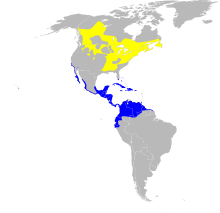American redstart
| American redstart | |
|---|---|
 |
|
| Male in Chiquimula, Guatemala | |
 |
|
| Female | |
| Scientific classification | |
| Kingdom: | Animalia |
| Phylum: | Chordata |
| Class: | Aves |
| Order: | Passeriformes |
| Family: | Parulidae |
| Genus: | Setophaga |
| Species: | S. ruticilla |
| Binomial name | |
|
Setophaga ruticilla (Linnaeus, 1758) |
|
 |
|
| S. ruticilla range Breeding range Wintering range | |
The American redstart (Setophaga ruticilla) is a New World warbler. It is unrelated to the Old World redstarts.
The genus name Setophaga is from Ancient Greek ses, "moth", and phagos, "eating", and the specific ruticilla is New Latin for "redstart" from Latin rutilus, "red", and New Latin cilla, "tail". "Redstart" refres to the male's red tail, "start" being an old word for tail.
The American redstart is a smallish warbler. It measures 11 to 14 cm (4.3 to 5.5 in) in total length and has a wingspan of 16 to 23 cm (6.3 to 9.1 in). Its length is boosted by a relatively long tail and it is one of the lightest birds in its family. Weight is considerably less in winter than in summer. Males weigh an average of 8.6 g (0.30 oz) in summer but drop to 7.2 g (0.25 oz) in winter, while females drop even more from an average of 8.7 g (0.31 oz) to an average of 6.9 g (0.24 oz). Among standard measurements, the wing chord is 5.5 to 6.9 cm (2.2 to 2.7 in), the tail is 4.9 to 5.8 cm (1.9 to 2.3 in), the bill is 0.7 to 0.9 cm (0.28 to 0.35 in) and the tarsus is 1.5 to 1.9 cm (0.59 to 0.75 in). The breeding males are unmistakable, jet black above apart from large orange-red patches on their wings and tails. Their breast sides are also orange, with the rest of their underparts colored white. In their other plumages, American redstarts display green in their upperparts, along with black central tails and grey heads. The orange patches of the breeding males are replaced by yellow in the plumages of the females and young birds. Orange and yellow coloration is due to the presence of carotenoids; males possess the red carotenoid canthaxanthin and the yellow carotenoids canary xanthophyll A and B, all of which mix together to produce an orange color, while the females possess only the yellow carotenoids. Recent research indicates that an age and sex effect on observed color attributes of hue, brightness, and saturation exists in American redstarts, with the exception for saturation, which only showed an age effect. Their song is a series of musical see notes. Their call is a soft chip.
Although perhaps not as common as in the past, this appears to be one of the most stable and abundant species of New World warbler, its numbers exceeded in total by the common yellowthroat, yellow warbler and yellow-rumped warbler, because of much wider natural breeding ranges in those species and perhaps exceeding those in sheer density within appropriate range. They breed in North America, across southern Canada and the eastern United States. These birds are migratory, wintering in Central America, the West Indies, and northern South America (in Venezuela they are called "candelitas"). They are very rare vagrants to western Europe. During the breeding season, this warbler inhabits open-canopy, mostly deciduous forests, second growth, and forest edge across much of the United States and southern Canada. This insectivorous bird often shares its foraging habitats with other warblers, and is found feeding in the mid to lower regions of a tree or shrub. A wide range of habitats are occupied during migration, including many shrubby areas. On their wintering grounds in Central and South America, this warbler may be found in nearly all woody habitats but tend to avoid non-forested agricultural areas. It is often found in shade-grown coffee plantations which provide native trees and shrubs, as well as coffee trees. Elevations occupied vary by location, as this species may be found at elevations up to 3,000 m (9,800 ft) in South America, but only up to 1,500 m (4,900 ft) in Jamaica.
...
Wikipedia

